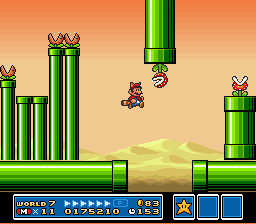World 7-Piranha Plant 1
| Level | |
|---|---|
| World 7- | |

| |
| Level code | World 7-Piranha Plant 1 |
| World | Pipe Land |
| Game | Super Mario Bros. 3 |
| Time limit | 200 seconds |
| << Directory of levels >> | |
World 7-![]() Piranha Plant 1 is the first of two Piranha Plant-based levels and the sixth level overall of Pipe Land in Super Mario Bros. 3, becoming accessible after the player has cleared World 7-4. While its own completion does not open another level, completing this level will allow the player to access a Toad House. This level will activate as soon as the player steps onto the Muncher on the map, and unlike the second Piranha Plant level, this one is optional, though it is placed in front of the gate that opens when the player clears World 7-
Piranha Plant 1 is the first of two Piranha Plant-based levels and the sixth level overall of Pipe Land in Super Mario Bros. 3, becoming accessible after the player has cleared World 7-4. While its own completion does not open another level, completing this level will allow the player to access a Toad House. This level will activate as soon as the player steps onto the Muncher on the map, and unlike the second Piranha Plant level, this one is optional, though it is placed in front of the gate that opens when the player clears World 7-![]() Fortress 1.
Fortress 1.
Layout
The player starts to the left of a pipe with a Piranha Plant, following which is a pipe with a Venus Fire Trap. Across the gap are small pipes with several Munchers moving in and out, alternating to a rhythm (with a standard Piranha Plant in the middle in the GBA version). The next gap has a Venus Fire Trap (Piranha Plant in the GBA remake) hanging from a pipe above, so the player needs to wait for it to retreat before they jump across. Going through the third Warp Pipe from the right will take the player to a small room where they can collect a Magic Wing, which will end the level upon being collected.
Enemies
| Name | Count |
|---|---|
Piranha Plant |
1 (red) 1 (green) |
Venus Fire Trap |
5 (green) |
Muncher |
32 |
Level statistics
- Power-ups: 1 (Magic Wing, gained at the end of the level)
- 1-Up Mushrooms: 0
- Secret areas: 0
Names in other languages
| Language | Name | Meaning |
|---|---|---|
| Japanese | ワールド7-パックン1[1] Wārudo 7-Pakkun 1 |
World 7-Piranha Plant 1 |
References
- ^ 「スーパーマリオコレクション新装復刻版―任天堂公式ガイドブック」 (Sūpā Mario Korekushon-Nintendo Kōshiki Guidebook), page 258.